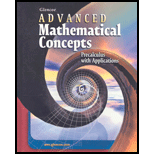
Concept explainers
(a)
To find: Theprobability of Trina to reach back from where she started the task.
(a)
Answer to Problem 41E
The probability to end up where she began is
Explanation of Solution
Given:
Trina tossed fair coin.
If its fall heads she walks
If its fall tails she walks
Concept used:
Binomial probability refers to the probability of exactly
If the probability of success on an individual trial is
Then the binomial probability is:
The probability is minimum
If
At least
At most
Calculation:
The number of times the coins flipped is:
To end up the where she began, she walked north and south
Hence, the probability to end up where she began is
(b)
To find: the probability within
(b)
Answer to Problem 41E
The probability within
Explanation of Solution
Given:
Trina tossed fair coin.
If its fall heads she walks
If its fall tails she walks
Concept used:
Binomial probability refers to the probability of exactly
If the probability of success on an individual trial is
Then the binomial probability is:
The probability is minimum
If
At least
At most
Calculation:
If she is within
The probability within
Hence, probability within
(c)
To find: The probability of exactly
(c)
Answer to Problem 41E
The exactly
Explanation of Solution
Given:
Trina tossed fair coin.
If its fall heads she walks
If its fall tails she walks
Concept used:
Binomial probability refers to the probability of exactly
If the probability of success on an individual trial is
Then the binomial probability is:
The probability is minimum
If
At least
At most
Calculation:
The number of times the coins flipped is:
To be exactly
Hence, exactly
Chapter 13 Solutions
Advanced Mathematical Concepts: Precalculus with Applications, Student Edition
Additional Math Textbook Solutions
Calculus: Early Transcendentals (2nd Edition)
University Calculus: Early Transcendentals (4th Edition)
Calculus: Early Transcendentals (3rd Edition)
Precalculus
 Calculus: Early TranscendentalsCalculusISBN:9781285741550Author:James StewartPublisher:Cengage Learning
Calculus: Early TranscendentalsCalculusISBN:9781285741550Author:James StewartPublisher:Cengage Learning Thomas' Calculus (14th Edition)CalculusISBN:9780134438986Author:Joel R. Hass, Christopher E. Heil, Maurice D. WeirPublisher:PEARSON
Thomas' Calculus (14th Edition)CalculusISBN:9780134438986Author:Joel R. Hass, Christopher E. Heil, Maurice D. WeirPublisher:PEARSON Calculus: Early Transcendentals (3rd Edition)CalculusISBN:9780134763644Author:William L. Briggs, Lyle Cochran, Bernard Gillett, Eric SchulzPublisher:PEARSON
Calculus: Early Transcendentals (3rd Edition)CalculusISBN:9780134763644Author:William L. Briggs, Lyle Cochran, Bernard Gillett, Eric SchulzPublisher:PEARSON Calculus: Early TranscendentalsCalculusISBN:9781319050740Author:Jon Rogawski, Colin Adams, Robert FranzosaPublisher:W. H. Freeman
Calculus: Early TranscendentalsCalculusISBN:9781319050740Author:Jon Rogawski, Colin Adams, Robert FranzosaPublisher:W. H. Freeman
 Calculus: Early Transcendental FunctionsCalculusISBN:9781337552516Author:Ron Larson, Bruce H. EdwardsPublisher:Cengage Learning
Calculus: Early Transcendental FunctionsCalculusISBN:9781337552516Author:Ron Larson, Bruce H. EdwardsPublisher:Cengage Learning





